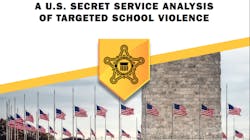School shooters typically show warning signs, report says
Most students who committed deadly school attacks over the past decade were badly bullied, had a history of disciplinary trouble and their behavior concerned others but was never reported, a new U.S. Secret Service study says.
The Associated Press reports that the Secret Service concluded that in at least four cases, attackers wanted to emulate other school shootings, including those at Columbine High School in Colorado, Virginia Tech University and Sandy Hook Elementary School in Connecticut.
The study by the Secret Service’s National Threat Assessment Center looked in depth at 41 school attacks from 2008 through 2017.
The information gleaned through the research will help train school officials and law enforcement on how to better identify students who may be planning an attack and how to stop them before they strike.
“These are not sudden, impulsive acts where a student suddenly gets disgruntled,” says Lina Alathari, chief of the threat assessment center. “The majority of these incidents are preventable."
The report covers 41 school attacks at K-12 schools. They were included in the study if the attacker was a current or recent former student within the past year who used a weapon to injure or kill at least one person at the school while targeting others.
Nineteen people were killed and 79 were injured in the attacks they studied; victims included students, staff and law enforcement.
The shootings happened quickly and were usually over within a minute or less. Law enforcement rarely arrived before an attack was over. Attacks generally started during school hours and occurred in one location, such as a cafeteria, bathroom or classroom.
Most attackers were male; seven were female. Researchers said 63% of the attackers were white, 15% were black, 5% Hispanic, 2% were American Indian or Alaska Native, 10% were of two or more races, and 5% were undetermined.
The weapons used were mostly guns; knives were used in some cases. One attacker used a World War II-era bayonet. Most of the weapons came from the attackers’ homes, the investigators reported.
Alathari says investigators were able to examine detailed information about attackers, including their home lives, suspension records and past behaviors.
No clear profile of a school attacker emerged from the study, but some details stand out: Many were absent from school before the attack, often through a school suspension; they were treated poorly by their peers in person, not just online; they felt mistreated; some sought fame, and others were suicidal. They fixated on violence and watched it online, played games featuring it or read about it in books.
The key to prevent such violence is knowing what to look for, recognizing the patterns and intervening early to try to stop someone from pursuing violence.
"A multidisciplinary threat assessment team, in conjunction with the appropriate policies, tools, and training, is the best practice for preventing future tragedies," the report's executive summary states. "A thorough review of the findings contained in this report should make clear that tangible steps can be taken to reduce the likelihood that any student would cause harm, or be harmed, at school."
About the Author
Mike Kennedy
Senior Editor
Mike Kennedy, senior editor, has written for AS&U on a wide range of educational issues since 1999.
